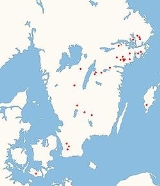
Viking Runestones
Encyclopedia
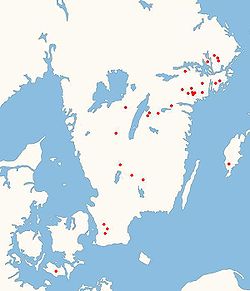
Scandinavia
Scandinavia is a cultural, historical and ethno-linguistic region in northern Europe that includes the three kingdoms of Denmark, Norway and Sweden, characterized by their common ethno-cultural heritage and language. Modern Norway and Sweden proper are situated on the Scandinavian Peninsula,...
ns who participated in Viking
Viking
The term Viking is customarily used to refer to the Norse explorers, warriors, merchants, and pirates who raided, traded, explored and settled in wide areas of Europe, Asia and the North Atlantic islands from the late 8th to the mid-11th century.These Norsemen used their famed longships to...
expeditions. This article treats the runestone that refer to people who took part in voyages abroad, in western Europe, and stones that mention men who were Viking warriors and/or died while travelling in the West. However, it is likely that all of them do not mention men who took part in pillaging. The inscriptions were all engraved in Old Norse
Old Norse
Old Norse is a North Germanic language that was spoken by inhabitants of Scandinavia and inhabitants of their overseas settlements during the Viking Age, until about 1300....
with the Younger Futhark
Younger Futhark
The Younger Futhark, also called Scandinavian runes, is a runic alphabet, a reduced form of the Elder Futhark, consisting of only 16 characters, in use from ca. 800 CE...
.
The largest group consists of 30 stones that mention England
England
England is a country that is part of the United Kingdom. It shares land borders with Scotland to the north and Wales to the west; the Irish Sea is to the north west, the Celtic Sea to the south west, with the North Sea to the east and the English Channel to the south separating it from continental...
, and they are treated separately in the article England Runestones
England Runestones
The England runestones is a group of about 30 runestones that refer to Viking Age voyages to England. They constitute one of the largest groups of runestones that mention voyages to other countries, and they are comparable in number only to the approximately 30 Greece Runestones and the 26 Ingvar...
. The runestones that talk of voyages to eastern Europe, the Byzantine Empire
Byzantine Empire
The Byzantine Empire was the Eastern Roman Empire during the periods of Late Antiquity and the Middle Ages, centred on the capital of Constantinople. Known simply as the Roman Empire or Romania to its inhabitants and neighbours, the Empire was the direct continuation of the Ancient Roman State...
and the Middle East are treated separately in the article Varangian Runestones
Varangian Runestones
The Varangian Runestones are runestones that mention voyages to the East or the Eastern route , or to more specific eastern locations such as Garðaríki ....
and its subarticles.
The most notable of the Viking runestones is the Kjula Runestone and it contains a poem in Old Norse
Old Norse
Old Norse is a North Germanic language that was spoken by inhabitants of Scandinavia and inhabitants of their overseas settlements during the Viking Age, until about 1300....
in the metre fornyrðislag that refers to the extensive warfare of a man called "Spear":
|
|
Below follows a presentation of the runestones based on the Rundata
Rundata
The Scandinavian Runic-text Data Base is a project involving the creation and maintenance of a database of runic inscriptions. The project's goal is to comprehensively catalog runestones in a machine-readable way for future research...
project. The transcriptions into Old Norse are in the Swedish and Danish dialect to facilitate comparison with the inscriptions, while the English translation provided by Rundata
Rundata
The Scandinavian Runic-text Data Base is a project involving the creation and maintenance of a database of runic inscriptions. The project's goal is to comprehensively catalog runestones in a machine-readable way for future research...
gives the names in the de facto standard dialect (the Icelandic and Norwegian dialect):
U 349
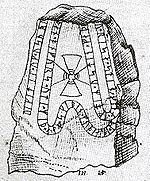
Latin transliteration:
- [uikitil × uk × usur -...u × risa × stin × þina * iftiR × ustin × faþ... ... ...þan × on furs × uti × miþ × ala × skibin × kuþ × ialbi × (a)t]
Old Norse transcription:
- Vikætill ok Ossurr [let]u ræisa stæin þenna æftiR Øystæin, fað[ur] ... [go]ðan. Hann fors uti með alla skipan. Guð hialpi and.
English translation:
- "Véketill and Ôzurr had this stone raised in memory of Eysteinn, ... good father. He perished abroad with all the seamen. May God help (his) spirit."
U 363
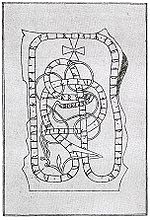
Urnes style
The Urnes style was the last phase of Scandinavian animal art during the second half of the 11th century and in the early 12th century. The preceding phases of Scandinavia's Viking Age animal ornamentation are usually categorized as Oseberg style, Borre style, Jelling style, Mammen style and...
. In this style the text bands end in serpert or beast heads depicted in profile.
Latin transliteration:
- [kislauk * lit * hakua * at sun sin * sbialtbuþi * ulfr * ikuar * hulfastr * kairi * þaiR * at broþur * sin * þiakn * fors * uti ok * at biarn faþur sin bro kirþu * ku=þ hialbi silu]
Old Norse transcription:
- Gislaug let haggva at sun sinn, Spiallbuði, UlfR, Ingvarr, Holmfastr, GæiRi, þæiR at broður sinn Þiagn, fors uti, ok at Biorn, faður sinn. Bro gærðu. Guð hialpi salu.
English translation:
- "Gíslaug had (this) cut in memory of her son; Spjallboði, Ulfr, Ingvarr, Holmfastr, Geiri, they made the bridge in memory of their brother Þegn, (who) perished abroad, and in memory of Bjôrn, their father. May God help (their) souls."
U 504
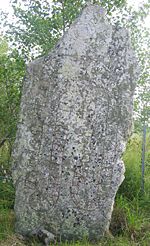
Latin transliteration:
- + kitil×fastr × risti × stin + þina × iftiR × askut × faþur + sin × saR × uas × uistr × uk × ustr + kuþ ialbi × as × salu
Old Norse transcription:
- Kætilfastr ræisti stæin þenna æftiR Asgaut, faður sinn. SaR vas vestr ok austr. Guð hialpi hans salu.
English translation:
- "Ketilfastr raised this stone in memory of Ásgautr, his father. He was in the west and in the east. May God help his soul."
U 611
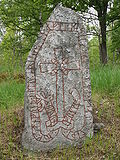
Freygeirr
Freygeirr was a Viking chieftain who probably led a leidang expedition. He is considered to have been active in the 1050s on the Baltic coast, and he has been identified on six runestones, Gs 13, DR 216, U 518, U 611, U 698 and U 1158.On the runestone Gs 13, Freygeirr is reported to be the leader...
. Pr 1 is also known as Ringerike style
Ringerike style
The Ringerike style is a Scandinavian animal style from the late 10th century and the 11th century, which evolved out of the earlier Mammen style. It has received its name from a group of runestones with animal and plant motifs in the Ringerike district north of Oslo. The most common motifs are...
, and this classification is used for inscriptions which depicts the serpent heads attached to the runic text bands in profile, but the serpents or beasts are not as elongated and stylized as in the Urnes style.
Latin transliteration:
- biurn : auk : stnfriþ : litu : arisa s--n : afti : kisila : han : uti : fial : i liþi : frekis *
Old Norse transcription:
- Biorn ok Stæinfrið letu ræisa s[tæi]n æftiR Gisla. Hann uti fioll i liði FrøygæiRs(?).
English translation:
- "Bjôrn and Steinfríðr had the stone raised in memory of Gísli. He fell abroad in Freygeirr's(?) retinue."
U 668
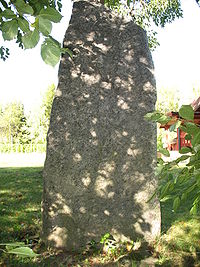
Johannes Bureus
Johannes Thomae Bureus Agrivillensis was a Swedish antiquarian, polymath and mystic. He was royal librarian, tutor, and adviser of King Gustavus Adolphus of Sweden....
' assistants and it was part of the wall of a manor house
Manor house
A manor house is a country house that historically formed the administrative centre of a manor, the lowest unit of territorial organisation in the feudal system in Europe. The term is applied to country houses that belonged to the gentry and other grand stately homes...
. After having been lost for 100 years it was rediscovered in the mid-19th century.
The stone is of high notability because it was raised in memory of one of the members of the Dano-English kings' personal guard, the Þingalið
Þingalið
The Thingmen was a standing army in the service of the Kings of England during the period 1013-51, financed by direct taxation which had its origins in the tribute known as Danegeld....
, consisting of elite warriors who mostly came from Scandinavia. This elite unit existed between 1016 and 1066. Another runestone raised in memory of a man who died in the same retinue is found in Södermanland
Södermanland
', sometimes referred to under its Latin form Sudermannia or Sudermania, is a historical province or landskap on the south eastern coast of Sweden. It borders Östergötland, Närke, Västmanland and Uppland. It is also bounded by lake Mälaren and the Baltic sea.In Swedish, the province name is...
, the Råby Runestone.
The Kolsta runestone is carved in runestone style Pr3, and it is not older than the mid-11th century as indicated by the use of dotted runes and the use of the ansuz rune
Ansuz rune
The a-rune , Younger Futhark was probably called *ansuz in Proto-Germanic, to which the Norse name Æsir is attributed.The shape of the rune is likely from Neo-Etruscan a , like Latin A ultimately from Phoenician aleph....
for the o phoneme.
Latin transliteration:
- ' sterkar * auk ' hioruarþr ' letu * reisa * þensa * stein at ' faþur sin keir(a) ' sum ' uestr ' sat ' i þikaliþi * kuþ hialbi salu
Old Norse transcription:
- Stærkarr ok Hiorvarðr letu ræisa þennsa stæin at faður sinn GæiRa, sum vestr sat i þingaliði. Guð hialpi salu.
English translation:
- "Styrkárr and Hjôrvarðr had this stone raised in memory of their father Geiri, who sat in the Assembly's retinue in the west. May God help (his) soul."
Sö 14

Canute the Great
Cnut the Great , also known as Canute, was a king of Denmark, England, Norway and parts of Sweden. Though after the death of his heirs within a decade of his own and the Norman conquest of England in 1066, his legacy was largely lost to history, historian Norman F...
.
Latin transliteration:
- rakna * raisti * stain * þansi * at * suin * buta * sit * auk * sifa * auk * r-knburk * at * sit * faþur * kuþ * hil[b]i * at * [hat]s * uit * iak * þet * uaR * sui- * uestr * miþ * kuti
Old Norse transcription:
- Ragna ræisti stæin þannsi at Svæin, bonda sinn, ok Sæfa ok R[a]gnborg at sinn faður. Guð hialpi and hans. Væit iak, þæt vaR Svæi[nn] vestr með Gauti/Knuti.
English translation:
- "Ragna raised this stone in memory of Sveinn, her husbandman, and Sæfa and Ragnbjôrg in memory of their father. May God help his spirit. I know that Sveinn was in the west with Gautr/Knútr."
Sö 53
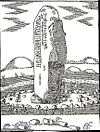
Latin transliteration:
- [lafR * raisþi * stain * þansi : iftiR * sulfu * sun sin : han uarþ : uastr * tauþr]
Old Norse transcription:
- OlafR ræisþi stæin þannsi æftiR Sylfu/Solfu, sun sinn. Hann varð vestr dauðr.
English translation:
- "Ólafr raised this stone in memory of Sylfa/Solfa, his son. He died in the west."
Sö 62
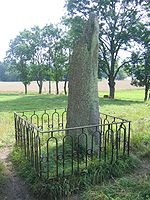
Latin transliteration:
- kuni : rasti stan : þansi : a ragna : sun san : kuþan : i uak : uaþ : taþR uastr
Old Norse transcription:
- Gunni ræisti stæin þannsi at Ragna, sun sinn goðan, i veg varð dauðr vestr.
English translation:
- "Gunni raised this stone in memory of Ragni, his good son; (he) died on the western route."
Sö 106
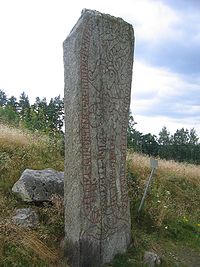
Eskilstuna
Eskilstuna is a city and the seat of Eskilstuna Municipality, Södermanland County, Sweden with 60,185 inhabitants in 2005. Eskilstuna has a large Sweden Finn population....
and Strängnäs
Strängnäs
Strängnäs is a locality and the seat of Strängnäs Municipality, Södermanland County, Sweden with 12,296 inhabitants in 2005. It is located by Lake Mälaren and is the episcopal see of the Diocese of Strängnäs, a former Roman Catholic and present Lutheran Diocese, with the Strängnäs Cathedral, built...
, which was also the location for the local assembly
Thing (assembly)
A thing was the governing assembly in Germanic and introduced into some Celtic societies, made up of the free people of the community and presided by lawspeakers, meeting in a place called a thingstead...
.
It tells of a man called Spjót ("spear") who had taken part in extensive warfare in western Europe. It is held to have been raised by the same aristocratic family as the Ramsund carving nearby and the Bro Runestone in Uppland
Uppland
Uppland is a historical province or landskap on the eastern coast of Sweden, just north of Stockholm, the capital. It borders Södermanland, Västmanland and Gästrikland. It is also bounded by lake Mälaren and the Baltic sea...
. Several Scandinavian authorities such as Sophus Bugge
Sophus Bugge
Sophus Bugge was a noted Norwegian philologist and linguist. His scientific work was directed to the study of runic inscriptions and Norse philology. Bugge is best known for his theories and his work on the runic alphabet and the Poetic Edda and Prose Edda. -Background:Elseus Sophus Bugge was...
, Erik Brate and Elias Wessén
Elias Wessén
Elias Wessén was a prominent Swedish linguist and a professor of Scandinavian languages at Stockholm University . In 1947, he was honoured with one of the 18 seats at the Swedish Academy .His earliest work concerned morphological problems in the Germanic languages, Onomasiology and Norse mythology...
have discussed the runestone and how extensive the warfare of Spjót could have been. Spjót, meaning "Spear", is a unique name and it may have been a name he earned as a warrior.
The text uses the term vestarla for "in the west" without specifying a location. Four other Viking runestones similarly use this term, Sö 137, Sö 164, Sö 173, and Sm 51.
Latin transliteration:
- alrikR ¤ raisti ¤ stain × sun × siriþaR × at × sin faþur × sbiut ×× saR × uisitaula × um × uaRit : hafþi × burg × um brutna : i : auk × um barþa +× firþ × han × kar(s)aR + kuni + alaR ×
Old Norse transcription:
- AlrikR ræisti stæin, sunn SigriðaR, at sinn faður Spiut, saR vestarla um vaRit hafði, borg um brutna i ok um barða, færð hann karsaR kunni allaR.
English translation:
- "Alríkr, Sigríðr's son, raised the stone in memory of his father Spjót, who had been in the west, broken down and fought in townships. He knew all the journey's fortresses."
Sö 137
.jpg)
Runestones at Aspa
The Runestones at Aspa are four runestones located at Aspa, which is about six kilometers north of Runtuna, Södermanland, Sweden, where a road has passed a creek since prehistoric times. One of the stones Sö Fv1948;289, below is the oldest surviving native Scandinavian source that mentions the...
and is classified as being carved in runestone style RAK. It was engraved with both long-branch runes and staveless runes
Staveless runes
Staveless runes were the climax of the simplification process in the evolution of runic alphabets that had started when the Elder Futhark was superseded by the Younger Futhark. In order to create the staveless runes, vertical marks were dropped from individual letters...
. In the last row all the words but the last one were written with staveless runes.
Latin transliteration:
- A þura : raisþi : stin : þ--si at : ubi : buanti : sin
- B : stain : saR:si : stanr : at : ybi : o þik*staþi : at ¶ : þuru : uar : han : uestarla : uakti : karla ¶ [sa þar] * sunr þaþ * raknasuatau(k)i(f)maR[sua]
Old Norse transcription:
- A Þora ræisþi stæin þ[ann]si at Øpi, boanda sinn.
- B Stæinn saRsi standr at Øpi a þingstaði at Þoru ver. Hann vestarla væknti(?) karla, sa þaR sunR það. ...
English translation:
- A "Þóra raised this stone in memory of Œpir, her husbandman."
- B "This stone stands in memory of Œpir, on the Assembly-place in memory of Þóra's husband. He armed(?) (his) men in the west. The son saw this there ..."
Sö 159
This runestone is tentatively categorized as being in runestone style RAK, and is located in Österberga. It has both long-branch runes and staveless runesStaveless runes
Staveless runes were the climax of the simplification process in the evolution of runic alphabets that had started when the Elder Futhark was superseded by the Younger Futhark. In order to create the staveless runes, vertical marks were dropped from individual letters...
. It was raised in memory of a father who had been in the west for a long time.
Latin transliteration:
-
: ikialtr : ak : aluiR : raisþu : stain : þansi : at : þurbiurn : faþur : sin : han uaistr hafR uf uaRit leki rorikR * kumytr biu * kunlaifR hiuku runaR
Old Norse transcription:
- Ingialdr ok AlveR/ØlveR ræisþu stæin þannsi at Þorbiorn, faður sinn. Hann vestr hafR of vaRit længi. HrøRikR(?), Guðmundr,
, GunnlæifR hiuggu runaR.
English translation:
- "Ingjaldr and Ôlvir raised this stone in memory of Þorbjôrn, their father. He has been long in the west. Hrœríkr(?), Guðmundr,
(and) Gunnleifr cut the runes."
Sö 164
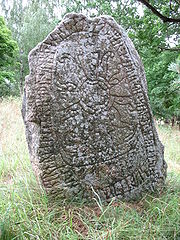
Cipher runes
Cipher runes, or cryptic runes, are the cryptographical replacement of the letters of the runic alphabet.-Preservation:The knowledge of cipher runes was best preserved in Iceland, and during the 17th and the 18th centuries, Icelandic scholars produced several treatises on the subject...
made of both short-twig runes and staveless runes
Staveless runes
Staveless runes were the climax of the simplification process in the evolution of runic alphabets that had started when the Elder Futhark was superseded by the Younger Futhark. In order to create the staveless runes, vertical marks were dropped from individual letters...
. The ornamentation is a ship where the mast is an artful cross. It is the only runestone with both text and iconography that refer to a ship. It was raised in memory of a man who took part in an expedition to the west where he was buried, and refers to him heroically in alliterative verse
Alliterative verse
In prosody, alliterative verse is a form of verse that uses alliteration as the principal structuring device to unify lines of poetry, as opposed to other devices such as rhyme. The most commonly studied traditions of alliterative verse are those found in the oldest literature of many Germanic...
or prose. This runestone is attributed to a runemaster
Runemaster
A runemaster or runecarver is a specialist in making runestones.Most early medieval Scandinavians were probably literate in runes, and most people probably carved messages on pieces of bone and wood. However, it was difficult to make runestones, and in order to master it one also needed to be a...
named Traen.
Latin transliteration:
- kuþbirn : uti : þaiR r(a)isþu : stan þansi : at : kuþmar : f(a)þur : sin : stuþ : triki:l(a) : i * stafn skibi : likR uistarla uf huln sar tu :
Old Norse transcription:
- Guðbiorn, Oddi, þæiR ræisþu stæin þannsi at Guðmar, faður sinn. Stoð drængila i stafn skipi, liggR vestarla of hulinn(?), saR do.
English translation:
- "Guðbjôrn (and) Oddi, they raised this stone in memory of Guðmarr, their father. He who died stood valiantly in the staff of the ship; (now) lies inhumed in the west."
Sö 173


The location was first described by Lukas Gadd during the nation-wide revision of pre-historic monuments that took place in the 17th century. In a paddock at the state owned homestead of Tystberga there was a flat stone lying with runes and next to it there was another flat stone that was leaning. In addition, there was a large square stone surrounded with rows of smaller stones, which Gadd described as a "fairly large cemetery". Not far from the stones, there were also two giant passage grave
Passage grave
thumb|250px|right|A simple passage tomb in [[Carrowmore]] near [[Sligo]] in IrelandA passage grave or passage tomb consists of a narrow passage made of large stones and one or multiple burial chambers covered in earth or stone. Megaliths are usually used in the construction of passage tombs, which...
s, about 20 paces long.
There is a depiction of the cross-less stone from the 17th century, made by Johan Hadorph
Johan Hadorph
Johan Hadorph was a Swedish director-general of the Central Board of National Antiquities. In 1667, he was appointed assessor at the government agency for antiquities, and in 1679, he became its director-general...
and Johan Peringskiöld
Johan Peringskiöld
Johan Peringskiöld was born in Strängnäs and died in Stockholm .His father was Lars Fredrik Peringer, a senior master at the gymnasium and his mother Anna Maria Mulich. He began his studies at Uppsala University in 1677 and he was an ardent student of the national antiquities...
. This depiction has helped scholars reconstruct the parts that are damaged today. The runestone was raised anew by Richard Dybeck
Richard Dybeck
Richard Dybeck was a Swedish jurist, antiquarian and lyricist, mainly remembered as the author of the lyrics to what is now the Swedish national anthem: Du gamla, Du fria....
in 1864. In 1936, Ivar Schnell examined the stone, and he noted that there was a large stone next to it. When this stone was raised, they discovered that it was also a runestone, and it was probably the one that had been previously described by Lukas Gadd as the "square stone". In the vicinity, Schnell found a destroyed stone without runes which probably was the leaning stone described by Gadd. Since they would hinder agriculture, the three stones were re-erected at a distance of 60 metres, at the side of the road. The stone circle
Stone circle (Iron Age)
The stone circles of the Iron Age were a characteristic burial custom of southern Scandinavia, especially on Gotland and in Götaland during the Pre-Roman Iron Age and the Roman Iron Age. In Sweden, they are called Domarringar , Domkretsar or Domarsäten...
and the other monuments described by Gadd could not be found anymore.
Regarding the names of the sponsors of the stone, the runes mani can be interpreted in two ways, since runic texts never repeat two runes consecutively. One possibility is that it refers to Máni
Mani
Mani is a name or word occurring in several etymologically unrelated languages and cultures, including:* Maní - a legend of the indigenous tribe Tupi in Brazil.* Mani , the founder of Manichaeism....
, the moon, and the other alternative is the male name Manni which is derived from maðr
Man (word)
The term man and words derived from it can designate any or even all of the human race regardless of their sex or age...
("man"). The runes mus:kia are more challenging and the older interpretation that it was Mus-Gea is nowadays rejected. It is probably a nominalization of myskia which means "darken" as during sunset, and one scholar has suggested that it could mean "sunset" and "twilight" and refer to e.g. a hair colour. A second theory is that the name refers to the animal bat
Bat
Bats are mammals of the order Chiroptera "hand" and pteron "wing") whose forelimbs form webbed wings, making them the only mammals naturally capable of true and sustained flight. By contrast, other mammals said to fly, such as flying squirrels, gliding possums, and colugos, glide rather than fly,...
. It is also disputed whether it is a man's name or a woman's name, but most scholars think that it refers to a woman. The name Myskia appears in a second runic inscription, Sö 13 from Gatstugan, and it may refer to the same person. The inscription echos the m-runes from the sponsors' names in the shape of the tongues of the two serpents.
The last part of the cross-less inscription is both unusual and partly problematic. The word ystarla could without context be interpreted as both "westwards" and "eastwards", but since an austarla appears later in the inscription, it is agreed that ystarla means "westwards". It is unusual, but not unique, that the y-rune
Ur (rune)
The reconstructed Proto-Germanic name of the Elder Futhark u rune is *Ūruz meaning "wild ox" or *Ûram "water". It may have been derived from the Raetic alphabet character u as it is similar in both shape and sound value...
(
 ) represents the v phoneme. An additional reason for this interpretation is the fact that it would allow the last part of the inscription to be interpreted as a poem in the meter fornyrðislag. This would explain the use of the rune since vestarla permits alliteration
) represents the v phoneme. An additional reason for this interpretation is the fact that it would allow the last part of the inscription to be interpreted as a poem in the meter fornyrðislag. This would explain the use of the rune since vestarla permits alliterationAlliteration
In language, alliteration refers to the repetition of a particular sound in the first syllables of Three or more words or phrases. Alliteration has historically developed largely through poetry, in which it more narrowly refers to the repetition of a consonant in any syllables that, according to...
with um vaRit. It is not known whether he refers to Hróðgeirr (Roger) or Holmsteinn, but most think that it is Holmsteinn who had been westwards. The plural ending -u in the verb form dou shows that both Hróðgeirr and Holmsteinn died in the Ingvar expedition.
Latin transliteration:
- A mus:kia : a(u)[k :] (m)an(i) : litu : rasa : ku[(m)(l) : þausi : at : b]ruþur * (s)in : hr(u)þkaiR * auk : faþur sin hulm:stain *
- B * han hafþi * ystarla u(m) : uaRit * lenki : tuu : a:ustarla : meþ : inkuari
Old Norse transcription:
- A Myskia ok Manni/Mani letu ræisa kumbl þausi at broður sinn HroðgæiR ok faður sinn Holmstæin.
- B Hann hafði vestarla um vaRit længi, dou austarla með Ingvari.
English translation:
- A "Myskja and Manni/Máni had these monuments raised in memory of their brother Hróðgeirr and their father Holmsteinn."
- B "He had long been in the west; died in the east with Ingvarr."
Sö 217

Latin transliteration:
- + suertikr : nuk + kari : auk : kuþmutr : auk : skari : auk : knutr : raistu : stain : þena : aftiR : utruk * faþur : sin : is fel * i liþi : kuþuis +
Old Norse transcription:
- SværtingR ok Kari ok Guðmundr ok Skari ok Knutr ræistu stæin þenna æftiR Otrygg, faður sinn, es fell i liði Guðvis.
English translation:
- "Svertingr and Kári and Guðmundr and Skári and Knútr raised this stone in memory of Ótryggr, their father, who fell in Guðvé's retinue."
Sö 260

Hakon Jarl Runestones
The Hakon Jarl Runestones are Swedish runestones from the time of Canute the Great.Two of the runestones, one in Uppland and one in Småland mention a Hakon Jarl, and both runologists and historians have debated whether they are one and the same, or two different men. Moreover, all known Hakon...
. It is not only the stone that has been found on the farm, but also a hoard of several hundred English coins. More Anglo-Saxon pence of this period have been found in Sweden than in England due to the Danegeld
Danegeld
The Danegeld was a tax raised to pay tribute to the Viking raiders to save a land from being ravaged. It was called the geld or gafol in eleventh-century sources; the term Danegeld did not appear until the early twelfth century...
s.
Omeljan Pritsak
Omeljan Pritsak
Omeljan Pritsak was the first Mykhailo Hrushevsky Professor of Ukrainian History at Harvard University and the founder and first director of the Harvard Ukrainian Research Institute.-Career:Pritsak began his academic career at the University of Lvov in interwar Poland where he...
argues that this Hakon is the same as the one who is mentioned on the Bro Runestone and whose son Ulf was in the west, i.e. in England. This Swedish Hakon Jarl would then actually be the Norwegian Hákon Eiríksson
Håkon Eiriksson
Håkon Eiriksson was Earl of Lade and king of Norway as a vassal under Knut the Great.Håkon Eiriksson was from a dynasty of Norwegian rulers in the eastern part of Trondheim, bordering the Trondheimsfjord. He was the son of Eirik Håkonson, ruler of Norway and earl of Northumbria...
.
Latin transliteration:
- ... ... ...a : stin : eftiR : ierunt : sun : sia : aR * uaR : uestþr : meþ ulfi : suni * hakunar *
Old Norse transcription:
- ... ... [ræis]a stæin æftiR Iarund, sun sinn, eR vaR vestr með Ulfi, syni HakonaR.
English translation:
- "... ... raise the stone in memory of Jôrundr, his son, who was in the west with Ulfr, Hákon's son."
Sö 319
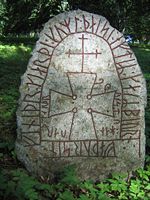
Manor house
A manor house is a country house that historically formed the administrative centre of a manor, the lowest unit of territorial organisation in the feudal system in Europe. The term is applied to country houses that belonged to the gentry and other grand stately homes...
Stäringe, where it is presently raised beside the runestone Sö 320. It is carved in runestone style RAK.
Latin transliteration:
-
: finiþr : kiarþi : kuml : þaisi : eftiR : kaiRbiurn : faþur sin :: han uarþ : tauþr uestr
Old Norse transcription:
- Finnviðr(?) gærði kuml þessi æftiR GæiRbiorn, faður sinn. Hann varð dauðr vestr.
English translation:
- "Finnviðr(?) made these monuments in memory of Geirbjôrn, his father. He died in the west."
Ög 68
This runestone was found at the church of Ekeby, and it was moved into the church porch in 1961. It is carved in runestone style RAK. It mentions the death of a man named Eyvindr who died while participating in an expedition westwards under a chieftain named Væringr. Erik Brate considers this Væringr to be the one who is mentioned on runestone Ög 111, below.Latin transliteration:
- suina × karþi × bru × þesi × eftiR × ouint × bruþur × sin × han × uas × uesteR × tauþeR × i × uereks × (k)ai-i
Old Norse transcription:
- Svæina gærði bro þessi æftiR Øyvind, broður sinn. Hann vas vestr dauðr i Værings
.
English translation:
- "Sveina made this bridge in memory of Eyvindr, his brother. He died in the west on Væringr's ..."
Ög 83
Ög 83 is one of the runestones of Högby and it is tentatively categorized as being in runestone style Pr1-Pr2. In this style the serpent or beast heads at the ends of the text bands are depicted in profile, but the serpents or beasts are not as elongated and stylized as in the Urnes style. It was made in memory of a son who died in the West.Latin transliteration:
-
* þura * sati * stin * þasi * aftiR * suin * sun * sin * Rs * uRstr * o * ualu
Old Norse transcription:
- Þora satti stæin þannsi æftiR Svæin, sun sinn, es vestr a
English translation:
- "Þóra placed this stone in memory of Sveinn, her son, who died in the west in
."
Ög 111
This inscription in runestone style Fp is located in the wall of the church of Landeryd. It was raised by a man named Væringr in memory of a brother who had served under Canute the GreatCanute the Great
Cnut the Great , also known as Canute, was a king of Denmark, England, Norway and parts of Sweden. Though after the death of his heirs within a decade of his own and the Norman conquest of England in 1066, his legacy was largely lost to history, historian Norman F...
. Erik Brate considers this Væringr to be same man as the one who is mentioned on runestone Ög 68, above. The cross is in Ringerike style
Ringerike style
The Ringerike style is a Scandinavian animal style from the late 10th century and the 11th century, which evolved out of the earlier Mammen style. It has received its name from a group of runestones with animal and plant motifs in the Ringerike district north of Oslo. The most common motifs are...
.
Latin transliteration:
-
* uirikR : resti : stan : eftiR : þialfa : bruþur : sin : trak : þan : aR * uaR * miR * knuti :
Old Norse transcription:
- VæringR ræisti stæin æftiR Þialfa, broður sinn, dræng þann, eR vaR með Knuti.
English translation:
- "Væringr raised the stone in memory of Þjalfi , his brother, the valiant man who was with Knútr."
Ög Fv1970;310
This runestone from the first half of the 11th century was discovered in June 1969 in the cemetery wall some 40 metres from the gate of the church of Kullerstad. The engraved side had been facing inwards. The stone was raised next to the entrance to the church. It is in light red granite and it is 1.84 m tall (1.55 m above the soil) and 84 cm wide. The length of the runes is between 12 and 15 cm. It was raised by Hákon in memory of his son Gunnarr and both men are also known from the runestone Ög 162 at Gunnar's bridge located about one-half km north of the church. The inscription on Ög 162 relates that Hákon named the bridge in memory of his son Gunnarr. The runestone which was discovered at the church was probably the main memorial, but it reports that at least two memorials had been raised in Gunnarr's memory. It is consequently likely that both runestones formed a twinned memorial at Gunnar's bridge, and they were probably made by the same runemasterRunemaster
A runemaster or runecarver is a specialist in making runestones.Most early medieval Scandinavians were probably literate in runes, and most people probably carved messages on pieces of bone and wood. However, it was difficult to make runestones, and in order to master it one also needed to be a...
.
Latin transliteration:
- hakun + raiþi × kuml × þausi × eftiR × kunar + sun × sin × han × uarþ × taurþ × uastr +
Old Norse transcription:
- Hakon ræisþi kumbl þausi æftiR Gunnar, sun sinn. Hann varð dauðr vestr.
English translation:
- "Hákon raised these monuments in memory of Gunnarr, his son. He died in the west."
Vg 61
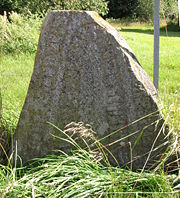
Latin transliteration:
-
: tula : sati : sten : þ... ...[iR kR : sun] : sin : harþa × kuþon : trok : sa × uarþ : tuþr : o : uastr:uakm : i : uikiku :
Old Norse transcription:
- Tola satti stæin þ[annsi æft]iR GæiR, sun sinn, harða goðan dræng. Sa varð dauðr a vestrvegum i vikingu.
English translation:
- "Tóla placed this stone in memory of Geirr, her son, a very good valiant man. He died on a Viking raid on the western route."
Vg 197

Latin transliteration:
- tuki * auk * þiR * bryþr * ristu * stin * þesi * eftiR : bryþr : sina * eR : uarþ * tu(þ)r uestr : en * anar : au(s)tr :
Old Norse transcription:
- Toki ok þæiR brøðr ræistu stæin þennsi æftiR brøðr sina. ER varð dauðr vestr, en annarr austr.
English translation:
- "Tóki and his brothers raised this stone in memory of their brothers. One died in the west, another in the east."
Sm 10
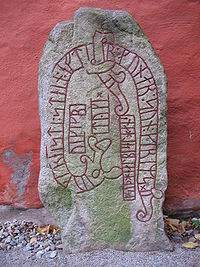
Latin transliteration:
- -u(k)i tyki × uikikr reisti * stein * e(f)tir : kunar : sun : kirims × kuþ healbi sel hans
Old Norse transcription:
- [T]oki, Toki vikingR, ræisti stæin æftiR Gunnar, sun Grims. Guð hialpi salu hans!
English translation:
- "Tóki, Tóki the Viking, raised the stone in memory of Gunnarr, Grímr's son. May God help his soul!"
Sm 42
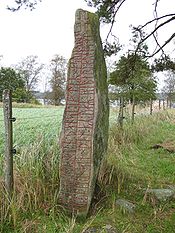
Harold Harefoot
Harold Harefoot was King of England from 1037 to 1040. His cognomen "Harefoot" referred to his speed, and the skill of his huntsmanship. He was the son of Cnut the Great, king of England, Denmark, and Norway by Ælfgifu of Northampton...
. Serving as a skipari or "seaman" on the king's longship was a great honour and Özurr was consequently part of the king's retinue, the þingalið
Þingalið
The Thingmen was a standing army in the service of the Kings of England during the period 1013-51, financed by direct taxation which had its origins in the tribute known as Danegeld....
. Other runestones unsing the title skipari include DR 82 in Sønder Vinge, DR 218 in Tågerup, DR 275 in Solberga, DR 363 in Sturkö, DR 379 in Ny Larsker, Sö 171 in Esta, and Sö 335 in Ärja. On this runestone, the runemaster used a bind rune
Bind rune
A bind rune is a ligature of two or more runes. They are extremely rare in Viking Age inscriptions, but are common in pre-Viking Age and in post-Viking Age inscriptions....
to combine the s-rune
Sowilo rune
*Sowilō or *sæwelō is the reconstructed Proto-Germanic name of the s-rune, meaning "sun". The name is attested for the same rune in all three rune poems...
and k-rune
Kaunan
The k-rune is called Kaun in both the Norwegian and Icelandic rune poems, meaning "ulcer". The reconstructed Proto-Germanic name is *Kaunan. It is also known as Kenaz , based on its Anglo-Saxon name.The Elder Futhark shape is likely directly based on Old Italic c / Latin C...
in skipari. According to a local tradition, "ancient coins" were once found near the stone, and these coins were possibly Özur's payment from his service in England.
Latin transliteration:
- tumi × risti : stin : þansi : iftiR × asur : bruþur × sin × þan : aR : uaR : s=kibari : hrhls : kunuks
Old Norse transcription:
- Tumi/Tummi/Domi ræisti stæin þannsi æftiR Assur, broður sinn, þann eR vaR skipari Haralds kunungs.
English translation:
- "Tumi/Tummi/Dómi raised this stone in memory of Ôzurr, his brother, he who was King Haraldr's seaman."
Sm 51
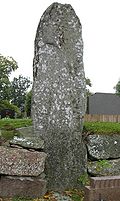
Latin transliteration:
- tusti × (r)...(i) ...tin × efti(R) kuno × mak × sin × þ... ...---s × ... × uistar- × uar- ...
Old Norse transcription:
- Tosti r[æist]i [s]tæin æftiR Gunna, mag sinn, ... ... ... vestar[la] var[ð] ...
English translation:
- "Tosti raised the stone in memory of Gunni, his kinsman-by-marriage ... ... ... was westwards ..."
G 370
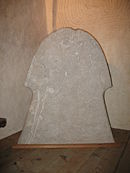
Latin transliteration:
- uatar : auk ... hilkaiR : raistu : stain : iftir ... hailka ... f-þur : sin : hn : uahR -istr : farin miþ uikikum
Old Norse transcription:
- Hvatarr ok HæilgæiRR(?) ræistu stæin aftiR Hæilga, f[a]ður sinn. Hann var [v]estr farinn með vikingum.
English translation:
- "Hvatarr and Heilgeirr(?) raised the stone in memory of Helgi, their father. He travelled to the west with the Vikings."
DR 266
This runestone, classified as being carved in runestone style RAK, was documented during the survey of runestones in the 17th century by Ole WormOle Worm
Ole Worm , who often went by the Latinized form of his name Olaus Wormius, was a Danish physician and antiquary.-Life:...
as being located at Uppåkra
Uppåkra
Uppåkra is a village located five kilometres south of Lund in Scania in southernmost Sweden.-History:Uppåkra was situated on the ancient main road between Trelleborg and Helsingborg in what was to become the Danish kingdom. The original foundation of Uppåkra is dated to the first century AD,...
, but it was later moved about 200 meters during the 19th century to Stenshöggård.
Latin transliteration:
- A nafni × risþi × stin × þasi ¶ aftiR × tuka × bruþur × si[n]
- B han × uarþ × uistr ¶ tuþr
Old Norse transcription:
- A Nafni resþi sten þæssi æftiR Toka, broþur sin.
- B Han warþ wæstr døþr.
English translation:
- A "Nafni raised this stone in memory of Tóki, his brother."
- B "He died in the west."
DR 330
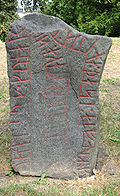
Lund
-Main sights:During the 12th and 13th centuries, when the town was the seat of the archbishop, many churches and monasteries were built. At its peak, Lund had 27 churches, but most of them were demolished as result of the Reformation in 1536. Several medieval buildings remain, including Lund...
. It is classified as being carved in runestone style RAK. Although the runic text has been damaged, it describes the relationship between the men using the word felaga or "partner," which is related to félag
Félag
Félag was a joint financial venture between partners in Viking Age society.-Etymology:The word félag is constructed by the word fé and a verbal base denoting "lay", the meaning being "to lay property together."The Old Norse word félagi "companion, comrade" originally meaning "one who has félag...
, a mechantile partnership or financial joint venture.
Latin transliteration:
- A ...usti : auk : kunar : ...u : stina : þasi : aiftiR : kn... ¶ ... ...biurn : filaka : si(n)(-)
- B : þiR : trikaR : uaRu : u--(-) --isiR : i * uikiku
Old Norse transcription:
- A Tosti(?) ok Gunnar ... stena þæssi æftiR ... [ok] ...biorn, felaga sin[a].
- B ÞeR drængiaR waRu w[iþa] [un]esiR i wikingu.
English translation:
- A "Tosti(?) and Gunnarr ... these stones in memory of ... [and] ...-bjôrn, their partners."
- B "These valiant men were widely renowned on viking raids."
DR 334
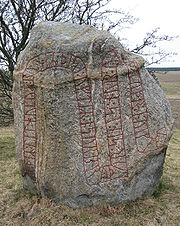
Menhir
A menhir is a large upright standing stone. Menhirs may be found singly as monoliths, or as part of a group of similar stones. Their size can vary considerably; but their shape is generally uneven and squared, often tapering towards the top...
and two runestones, DR 334 and DR 335
Västra Strö 2 Runestone
The Västra Strö 2 Runestone, listed as DR 335 in the Rundata catalog, is a Viking Age memorial runestone located at the Västra Strö Monument, which is at a church that is about four kilometers northwest of Eslöv, Skåne County, Sweden.-Description:...
. The monument was in good shape when documented by Ole Worm in 1643, but a survey in 1876 found that all of the stones had fallen except one. The monument was restored in 1932 by the Lund Kulturen
Kulturen
Kulturen is a museum in Lund, Sweden. Kulturen is Sweden's second oldest open-air museum after Skansen in Stockholm. The complete name of the museum is Kulturhistoriska föreningen för södra Sverige.-History:...
. The inscription on DR 334 is considered to have been carved by the same runemaster who did DR 335, which memorializes a deceased ship owner. Both memorial runestones were also sponsored by the same man, Faðir, who on DR 334 memorializes his deceased brother Ôzurr, who died i wikingu or on a Viking raid or expedition. It has been suggested that all three men may have participated on this raid or expedition.
The stone is known locally as the Västra Ströstenen 1.
Latin transliteration:
- faþiR : lit : hukua : runaR : þisi : uftiR : osur : bruþur : sin : is : nur : uarþ : tuþr : i : uikiku :
Old Norse transcription:
- FaþiR let hoggwa runaR þæssi æftiR Azur, broþur sin, æs nor warþ døþr i wikingu.
English translation:
- "Faðir had these runes cut in memory of Ôzurr, his brother, who died in the north on a viking raid."
DR 216
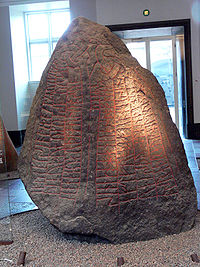
Lolland
Lolland is the fourth largest island of Denmark, with an area of 1,243 square kilometers . Located in the Baltic sea, it is part of Region Sjælland...
, Denmark
Denmark
Denmark is a Scandinavian country in Northern Europe. The countries of Denmark and Greenland, as well as the Faroe Islands, constitute the Kingdom of Denmark . It is the southernmost of the Nordic countries, southwest of Sweden and south of Norway, and bordered to the south by Germany. Denmark...
. It is the earliest native Scandinavian document that mentions Sweden
Sweden
Sweden , officially the Kingdom of Sweden , is a Nordic country on the Scandinavian Peninsula in Northern Europe. Sweden borders with Norway and Finland and is connected to Denmark by a bridge-tunnel across the Öresund....
together with the runestones DR 344 and Sö Fv1948;289. It is raised in memory of a Viking who died in Sweden and according to one reading, he fought in the retinue of Freygeirr
Freygeirr
Freygeirr was a Viking chieftain who probably led a leidang expedition. He is considered to have been active in the 1050s on the Baltic coast, and he has been identified on six runestones, Gs 13, DR 216, U 518, U 611, U 698 and U 1158.On the runestone Gs 13, Freygeirr is reported to be the leader...
. It is on permanent display at the Danish National Museum
National Museum of Denmark
The National Museum of Denmark in Copenhagen is Denmark’s largest museum of cultural history, comprising the histories of Danish and foreign cultures, alike. The museum's main domicile is located a short distance from Strøget at the center of Copenhagen. It contains exhibits from around the world,...
.
Latin transliteration:
- A osraþr auk hiltu(-)-R raisþu stain þansi aft froþa fronti sin sin ian han uas þo foink uaiRa ian han uarþ tauþr o suoþiauþu auk uas furs i frikis ioþi þo aliR uikikaR
Old Norse transcription:
- Asraþr ok Hildu[ng]R/Hildv[ig]R/Hildu[lf]R resþu sten þænsi æft Fraþa/Fræþa, frænda sin sin, æn han was þa fækn(?) wæRa, æn han warþ døþr a Sweþiuþu ok was fyrst(?) i(?) Friggis(?) liði(?) þa alliR wikingaR.
English translation:
- "Asrathr and Hildung/Hildvig/Hildulf erected this stone after Fretha, their kinsman, ... he died in Sweden and was first .... of every viking."
Sources
- Brate, Erik (1922). Sverges Runinskrifter. Stockholm, Bokförlaget Natur och Kultur.
- Enoksen, Lars MagnarLars Magnar EnoksenLars Magnar Enoksen is a Swedish writer and Glima wrestler.Enoksen was born in Malmö in 1960 with a Swedish mother and Norwegian father....
(1998). Runor: Historia, Tydning, Tolkning. Historiska Media, Falun. ISBN 91-88930-32-7 - Jansson, Sven B. (1980). Runstenar. STF, Stockholm. ISBN 91-7156-015-7
- Peterson, Lena (2002). Nordisk Runnamnslexikon, at the Swedish Institute for Linguistics and Heritage (Institutet för Språk och Folkminnen).
- Pritsak, OmeljanOmeljan PritsakOmeljan Pritsak was the first Mykhailo Hrushevsky Professor of Ukrainian History at Harvard University and the founder and first director of the Harvard Ukrainian Research Institute.-Career:Pritsak began his academic career at the University of Lvov in interwar Poland where he...
. (1981). The Origin of Rus' . Cambridge, Mass.: Distributed by Harvard University Press for the Harvard Ukrainian Research Institute. ISBN 0-674-64465-4 - Project Samnordisk Runtextdatabas Svensk - RundataRundataThe Scandinavian Runic-text Data Base is a project involving the creation and maintenance of a database of runic inscriptions. The project's goal is to comprehensively catalog runestones in a machine-readable way for future research...
- The article Kjula in NationalencyklopedinNationalencyklopedinNationalencyklopedin is the most comprehensive contemporary Swedish language encyclopedia, initiated by a favourable loan from the Government of Sweden of 17 million Swedish kronor in 1980, which was repaid by December 1990...
. - A Swedish site on the runestone.

